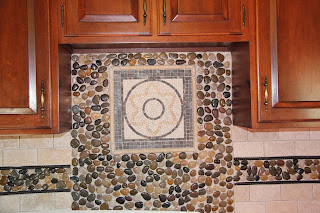In all honesty, the process is very similar to how we laid our granite tile. Although the process for grouting had us a bit baffled so I figured this was good to share in case you're planning on installing pebble tile as well.
I didn't include photos of the process in this post, for photos, you can see our tutorial on laying our granite counter tops.
Step one: calculate square footage and linear feet
Depending on the design you're planning on doing (one type of tile all over, or incorporating a few different kinds of tiles) You'll need to know how many square feet you'll need of each type of tile and if you're planning on adding things like pencil railing or any type of border, you'll need to make sure you have the linear feet on hand too.
To be honest, math is not my strong suit. What worked for me was deciding what types of tiles I wanted to incorporate and then deciding how much I could use where.
For instance, after we installed the counter top, we had a clearance of 17.75" between the counter and the cabinet. So, I ended up taking the travertine (3"x6") pebble tile (~4") and the pencil railing (.5") and worked out what would use up all of that space (or if I had to come up with something else). Also figure in the spacing between the tiles too (we used 1/8" spacers)
It was just enough space for 2 rows of travertine, a line of pencil railing, the pebble tile, another line of pencil railing and another 2 rows of travertine. For someone who isn't very good at math, I was rather impressed with myself!
When purchasing your tile, always make sure to buy about 10% extra - especially when using natural stone. Chances are some of the tiles are chipped, broken, or for some reason just don't look "right." Garry gets a little crazy and ends up buying 30% more than we need, but at least we can always take it back. (That's on the agenda for today)
Step two: draw a diagram of your back splash
It doesn't have to be completely to scale, but draw out how you want your back splash to look. It will certainly help as a guide when you're in the middle of the project, or if someone else is helping you.
Step three: install cement backer board
Ideally, you would have done this before installing your counter top if you were planning on remodeling both. If you aren't planning on changing out your counter, then you'll need to take down the existing tile. If there is backer board is already there, awesome! You can just sand it down and start there. If it's like our house and the tiles were essentially "glued" on to the drywall, you'll need to install the backer board.
Installation is easy. You cut out the size you need to cover the entire wall. The cutting is also easy because all you need to do is score and snap. So all you'll need is a box cutter, t-square, marker and a tape measure. Once you get your backer board measured and cut, secure it to the wall with 3" drywall screws, making sure that you drill into the studs. Depending on how heavy your tile is, you'll want more screws. Since we used natural stone, we drilled every 4" into the studs.
Step four: protect your counter top
Trust me, you don't want to muss up your counters! I went ahead and put a few strips of painters' tape along the corner where the wall meets the counter. You'll want at least a few inches of space (because thinset and grout is really messy) to prevent from having to wipe up spills every few seconds. Also, you can cover your entire counter top with construction paper if you want. We didn't purely based on laziness and not wanting to buy one more thing.
Once your counter is protected and safe, move on to the next step...
Step five: thinset the backer board
Grab your trowel (and in my case a large putty knife as well) and start spreading that thinset! You'll want to add an even .25" or so layer of thinset to a small area (remember, you have to lay the tile within 30 minutes of applying the thinset, so the key here is to not do more than you can lay in that period of time, so dividing the back splash into sections is really helpful) and then go back over it with another .25" layer with the notched end of your trowel. If you're using natural stone or other "heavier" material, you definitely want to make sure that you have enough thinset - otherwise the tiles won't adhere properly and will fall off the wall.
Step six: lay the tile
If you are like Garry and I, this is going to be the highlight of your weekend. With laid our tile in the traditional "brick" pattern. To save Garry some frustration, I had him make the cuts as we went along instead of trying to measure it all out and cut ahead of time. This really helped because the subway tile wasn't exactly evenly cut all the way around. There were notches and indents (which is why we love it, we were definitely going for "perfectly imperfect") so trying to get an exact measurement would've driven him nuts. Plus, there were some places where the spacing needed to be adjusted (due to a cabinet being hung slightly lower than another). Overall, it was less stress on him and made the process go a lot smoother. Don't forget to put your spacers in while you're laying the tile too!
A note on pebble tile:
When you're laying pebble tile, make sure that the mesh backing "sticks" into the thinset. This tile is fairly heavy and needs the mesh to help "hold it up." It helps to gently press each stone into the thinset as you're laying it. This will ensure that it will stay put on the wall and not slide around while you're working. Also make sure to wipe any thinset off the pebble surface (because it's a pain in the butt to scrape off after it dries). You will also want to make sure that you don't have thinset oozing out between the spaces of your tile, so make sure to clean that up.
Once you're finished laying the tile, you'll want to wait 24 hours while the thinset cures before you apply the grout.
Finally! A better photo!
Gorgeous sunlight streaming in... making it difficult to take photos
The piece that inspired it all - the lotus mosaic!
It just makes me happy.... :)
Step seven: grout the tileYou'll want to mix the grout according to the directions on the container. While you wait for the grout to set (before mixing again) take the spacers out of the wall. If you bought the fancy pre-mixed stuff, go right ahead and start (but still take the spacers out first!).
Take your rubber float and apply a generous amount of grout to the tile. Tile the float at a 45* angle and push/scrape the grout into the cracks. Do this until all the spaces are covered.
A note on pebble tile:
OMG does this require a lot of grout! While it's absolutely beautiful and worth every frustrating moment of it, grouting pebble tile is not easy. Since the pebbles have varying thickness and the space between pebbles varies, it gets to be rather cumbersome. We actually used a smaller margin float to do the job and that seemed to help. We also ended up needing double the grout we would normally use, so if you're planning on doing pebble tile, make sure to buy double the grout you would normally use for that area. Be patient, as I promise, it will be worth it when you're done.
Step eight: wipe excess off tile
After waiting 15 minutes or so (enough time for the grout to start curing, but it's not dry yet) wipe down the excess grout on your tile. (With the pebble tile, there will be a lot). I found that using the scrubby side of the shop sponge to get the grout out of the cracks and then use the smooth side to wipe it off really helped. With our pencil railing, we had to use a kitchen sponge because the crevices were so small.
Once you get most of the excess off, wait 2 hours and then sponge off again.
Step nine: final cleaning and sealing
After you're done with the second cleaning, you'll probably be tired and want to take a nap. Now is a good time because you need to wait at least 24 hours before you do the final cleaning and at least 48 hours before you seal.
When doing the final cleaning, use either a microfiber cloth or cheesecloth to clean as much of the grout off of the tiles as possible. When the appropriate time has elapsed, seal the back splash according to the product's instructions. With natural stone, you will want to put a few coats of sealant on it, especially in the kitchen. At this point, you can peel up your painter's tape, construction paper, whatever you used to protect your counter top and admire your work.
We still need to wipe off some more grout (it was caked on there pretty thick)
I love how the pebbles really tie together the cabinets, mosaic and counter tops! The grout really lightened everything up as well, making it feel less dark and "cave-like"
Before
After (we still have a bit of clean-up and decorating to do)
While Garry works at getting the rest of the grout off, de-hazing the tile and sealing it, I'll be painting and making new curtains!
We took a mad-dash at cleaning last night too. Let me tell you - construction is dirty work and cleaning the kitchen was no small task! During our major "spring cleaning" I'll be de-greasing the cabinet doors and putting some new shelf liners in the drawers and cabinets, plus some organization of the pantry.
Overall, there are still some small tweaks that need to be made around the outlets where things didn't fit quite right. Yeah, we know that's something we should have checked before letting the thinset cure - chalk that one up to experience. Luckily we have extra tiles (both the pebble and travertine) that it won't be a problem to take care of. All of our previous tiling projects have been on surfaces without outlets, so this was a new one for us. Live and learn right? And now... onto painting... :D :D :D :D :D :D









No comments:
Post a Comment